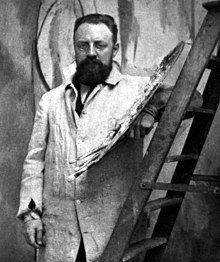
Back Henri Matisse Afrikaans Henri Matisse ALS Матисс, Анри ALT አንሪ ማቲስ Amharic Henri Matisse AN هنري ماتيس Arabic ܗܢܪܝ ܡܐܛܝܣ ARC هينرى ماتيس ARZ হেনৰি মেটিশ্ব Assamese Henri Matisse AST
This article may have too many section headers. (August 2024) |
Henri Matisse | |
|---|---|
 Matisse in 1913 | |
| Born | Henri Émile Benoît Matisse 31 December 1869 Le Cateau-Cambrésis, France |
| Died | 3 November 1954 (aged 84) Nice, France |
| Education | Académie Julian, William-Adolphe Bouguereau, Gustave Moreau |
| Known for |
|
| Notable work | Woman with a Hat (1905) The Joy of Life (1906) Nu bleu (1907) La Danse (1909) L'Atelier Rouge (1911) The Snail (1953) |
| Movement | Fauvism, Modernism, Post-Impressionism |
| Spouse |
Amélie Noellie Parayre
(m. 1898; div. 1939) |
| Children | 3 |
| Patron(s) | Sergei Shchukin, Gertrude Stein, Etta Cone, Claribel Cone, Sarah Stein, Albert C. Barnes |
| Signature | |
Henri Émile Benoît Matisse (French: [ɑ̃ʁi emil bənwa matis]; 31 December 1869 – 3 November 1954) was a French visual artist, known for both his use of colour and his fluid and original draughtsmanship. He was a draughtsman, printmaker, and sculptor, but is known primarily as a painter.[1]
Matisse is commonly regarded, along with Pablo Picasso, as one of the artists who best helped to define the revolutionary developments in the visual arts throughout the opening decades of the twentieth century, responsible for significant developments in painting and sculpture.[2][3][4][5]
The intense colourism of the works he painted between 1900 and 1905 brought him notoriety as one of the Fauves (French for "wild beasts"). Many of his finest works were created in the decade or so after 1906, when he developed a rigorous style that emphasized flattened forms and decorative pattern. In 1917, he relocated to a suburb of Nice on the French Riviera, and the more relaxed style of his work during the 1920s gained him critical acclaim as an upholder of the classical tradition in French painting.[6] After 1930, he adopted a bolder simplification of form. When ill health in his final years prevented him from painting, he created an important body of work in the medium of cut paper collage.
His mastery of the expressive language of colour and drawing, displayed in a body of work spanning over a half-century, won him recognition as a leading figure in modern art.[7]
- ^ Myers, Terry R. (July–August 2010). "Matisse-on-the-Move". The Brooklyn Rail.
- ^ "Tate Modern: Matisse Picasso". Tate.org.uk. Retrieved 13 February 2010.
- ^ Adrian Searle (7 May 2002). "Searle, Adrian, A momentous, tremendous exhibition, The Guardian, Tuesday 7 May 2002". Guardian. UK. Retrieved 13 February 2010.
- ^ "Trachtman, Paul, Matisse & Picasso, Smithsonian, February 2003". Smithsonianmag.com. Retrieved 13 February 2010.
- ^ "Duchamp's urinal tops art survey". news.bbc.co.uk. 1 December 2004. Retrieved 10 December 2010.
- ^ Wattenmaker, Richard J.; Distel, Anne, et al. (1993). Great French Paintings from the Barnes Foundation. New York: Alfred A. Knopf. ISBN 0-679-40963-7. p. 272
- ^ Magdalena Dabrowski Department of Nineteenth-Century, Modern, and Contemporary Art, The Metropolitan Museum of Art Source: Henri Matisse (1869–1954) | Thematic Essay | Heilbrunn Timeline of Art History | The Metropolitan Museum of Art Retrieved 30 June 2010.